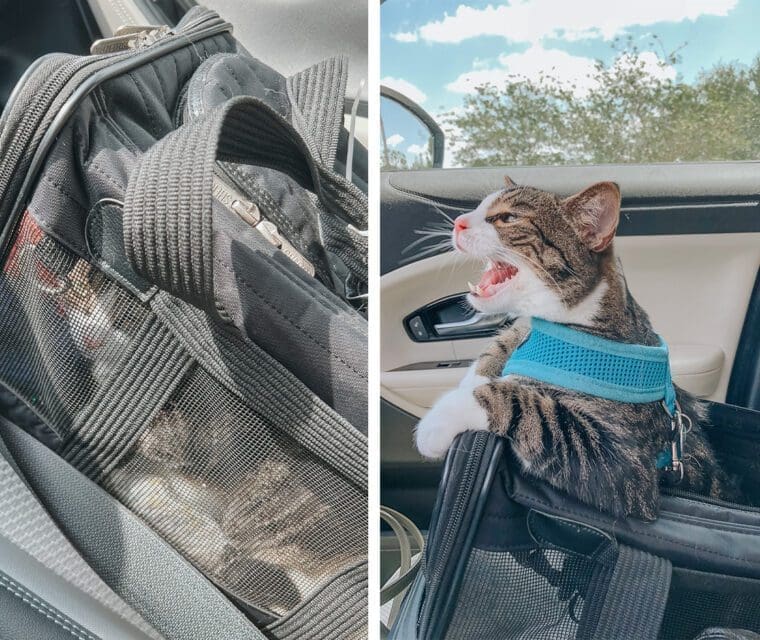Moving with Cats & Coffee, Part 2
Moving is not the most intuitive process in the world. It seems easy enough: pack up your things from point A and transport them to point B. But, whether you’re moving across the city or across the country, there are a number of pitfalls and inefficiencies that can occur along the way. Having recently moved myself, I designed this series to offer advice on things that went right and — perhaps more importantly — what didn’t go right. You can expect four posts in the Moving with Cats & Coffee Series, published every other week, on topics such as packing tips for moving and things to do ahead of a move.
This post covers three categories of advice for moving with cats:
- Things to Do With Cats Before a Move
- Packing Necessities for Your Cats
- Introducing Your Cat to Your New Home
Shop Travel Necessities for Cats
Whether you’re adopting your first cat or adding to your clowder,
my Cat Care Guide covers everything you need to know about giving your cat their best life!
Check out my full Cat Care Guide here!
Advice for Moving with Cats: Insights Based on My Recent Move
Cats are temperamental little creatures. I’ve touched on my experience with cat anxiety in some of my Cat Mom Life posts — particularly this one about using cat pheromones in the home — and really tried to prepare the cats for the move this time around.
While my cats travel well, they can take a while to get acclimated to a new place, particularly a place that doesn’t smell at all familiar. I’ve broken down my Cat Mom Life moving advice into three categories: things to do before a move, packing for your furbaby, and tips on facilitating introductions to the new home.
P.S. if you are looking for more moving advice, be sure to check out the rest of my moving guide here. If you are looking for tips with moving with a toddler, I recommend checking out this guide here.

Things to Do With Cats Before a Move
- If applicable, reach out to your vet for calming medication.
- Many vets are very understanding about the anxiety that travel and moving can have on pets, and they likely have more advice for you based on your pet’s individual history.
- Retrieve veterinary medical records for your pets.
- Even if you’re moving within town and will be keeping the same vet, your new apartment or landlord may require proof of vaccinations, etc.
- Pick up or order Feliway pheromones and catnip spray to help minimize stress in the days leading up to a move.
- Trim your cat’s nails before the move — in case you can’t find the clippers when you move (learn from my mistakes).

Packing Necessities for Your Cats
- Pack a bag or box of 3-5 days worth of supplies on hand. Supplies include:
- (1) Kibble,
- (2) Wet food,
- (3) Bowls,
- (4) A spoon for wet food and a cup for kibble,
- (5) Any prescription medications, and
- (6) A litter box with extra litter.
- Gather and pack comfort items for your cat. These can include items such as beds, toys, blankets, etc. — anything that will make your pet feel more comfortable and “at home” in the new home.
- Make the carriers comfy and put them out for your cat to check out before the move.
- This gives them the opportunity to get a bit more comfortable with the carrier as a safe space than they might usually be.
- I recommend using catnip and Feliway spray within the carrier, while lining it with comfort items, such as favorite blankets (might I suggest a Cat Mat?) and toys.

Introducing Your Cat to Your New Home
- Utilize Feliway pheromones and catnip spray to help minimize stress. Plug in a diffuser once you get inside!
- At first, keep your cat or cats in a single room.
- This is particularly important if you have movers coming to deliver furniture after you arrive, as it helps you keep an eye on where the cats are and what they’re doing. But is also just generally helpful to reduce anxiety. A smaller space is less intimidating or overwhelming.
- Set up a litter box and put out some food and water.
- Make sure your cat knows the litter box is there, and keep an eye on the food and water. Sometimes eating behaviors can be different when stressed, so that’s just something to monitor.
- Set up comfort items as you can.
- Place blankets and beds around, keep the carriers out as a safe space, and try to sit on the floor and play with your cat so they can see you’re not anxious or concerned. I found this made a huge difference in our recent move!
Cat Toys, Pheromones, & More Cat Mom Life Favorites
Read More of the Moving Series from Cats & Coffee
- 15 Things to Do Before a Move – There are some important things to get done before a move. But what does it mean to be move-in ready? Read on for 15 action items that will make your life so much easier.
- Packing Tips for Moving: What Worked (& Didn’t) for My Recent Move – Read up on what stands out as having worked for my recent move – and, perhaps just as importantly, what didn’t, here!
- Moving Day Checklist: What to Do & Keep With You – Free moving day checklists: one covering things to do on the day, and the other relating to things to keep with you on the day of your move, both available here!
*This post was originally published in June 2021. It was most recently updated on September 17, 2023.


